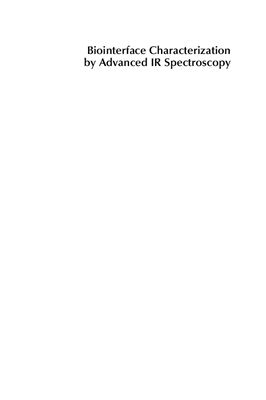Elsevier, Amsterdam, 2011, 327 pages
IR spectroscopy has become without any doubt a key technique to answer questions raised when studying the interaction of proteins or peptides with solid surfaces for a fundamental point of view as well as for technological applications.
This book presents fundamental concepts associated with the characterization of biomolecules at surfaces in a variety of environments (vacuum, vapor, liquid), all centered on the use of infrared radiation as a probe. Each chapter focuses on a particular probing configuration and discusses both experimental issues/optimization schemes and scientific issues specific to using such an approach to study biomolecules. Examples are presented for the most relevant systems involving bio-related or biological interfaces, thus providing a practical advice for researchers in biomedical and chemical engineering and researchers using or optimizing bio-films or biosensors.
Principle, experimental set ups, parameters and interpretation rules of several advanced IR-based techniques; application to biointerface characterisation through the presentation of recent examples, will be given in this book. It will describe how to characterise amino acids, protein or bacterial strain interactions with metal and oxide surfaces, by using infrared spectroscopy, in vacuum, in the air or in an aqueous medium. Results will highlight the performances and perspectives of the technique.
Description of the principles, expermental setups and parameter interpretation, and the theory for several advanced IR-based techniques for interface characterisation
Contains examples which demonstrate the capacity, potential and limits of the IR techniques
Helps finding the most adequate mode of analysis
Contains examples
Contains a glossary by techniques and by keywords
IR spectroscopy has become without any doubt a key technique to answer questions raised when studying the interaction of proteins or peptides with solid surfaces for a fundamental point of view as well as for technological applications.
This book presents fundamental concepts associated with the characterization of biomolecules at surfaces in a variety of environments (vacuum, vapor, liquid), all centered on the use of infrared radiation as a probe. Each chapter focuses on a particular probing configuration and discusses both experimental issues/optimization schemes and scientific issues specific to using such an approach to study biomolecules. Examples are presented for the most relevant systems involving bio-related or biological interfaces, thus providing a practical advice for researchers in biomedical and chemical engineering and researchers using or optimizing bio-films or biosensors.
Principle, experimental set ups, parameters and interpretation rules of several advanced IR-based techniques; application to biointerface characterisation through the presentation of recent examples, will be given in this book. It will describe how to characterise amino acids, protein or bacterial strain interactions with metal and oxide surfaces, by using infrared spectroscopy, in vacuum, in the air or in an aqueous medium. Results will highlight the performances and perspectives of the technique.
Description of the principles, expermental setups and parameter interpretation, and the theory for several advanced IR-based techniques for interface characterisation
Contains examples which demonstrate the capacity, potential and limits of the IR techniques
Helps finding the most adequate mode of analysis
Contains examples
Contains a glossary by techniques and by keywords

